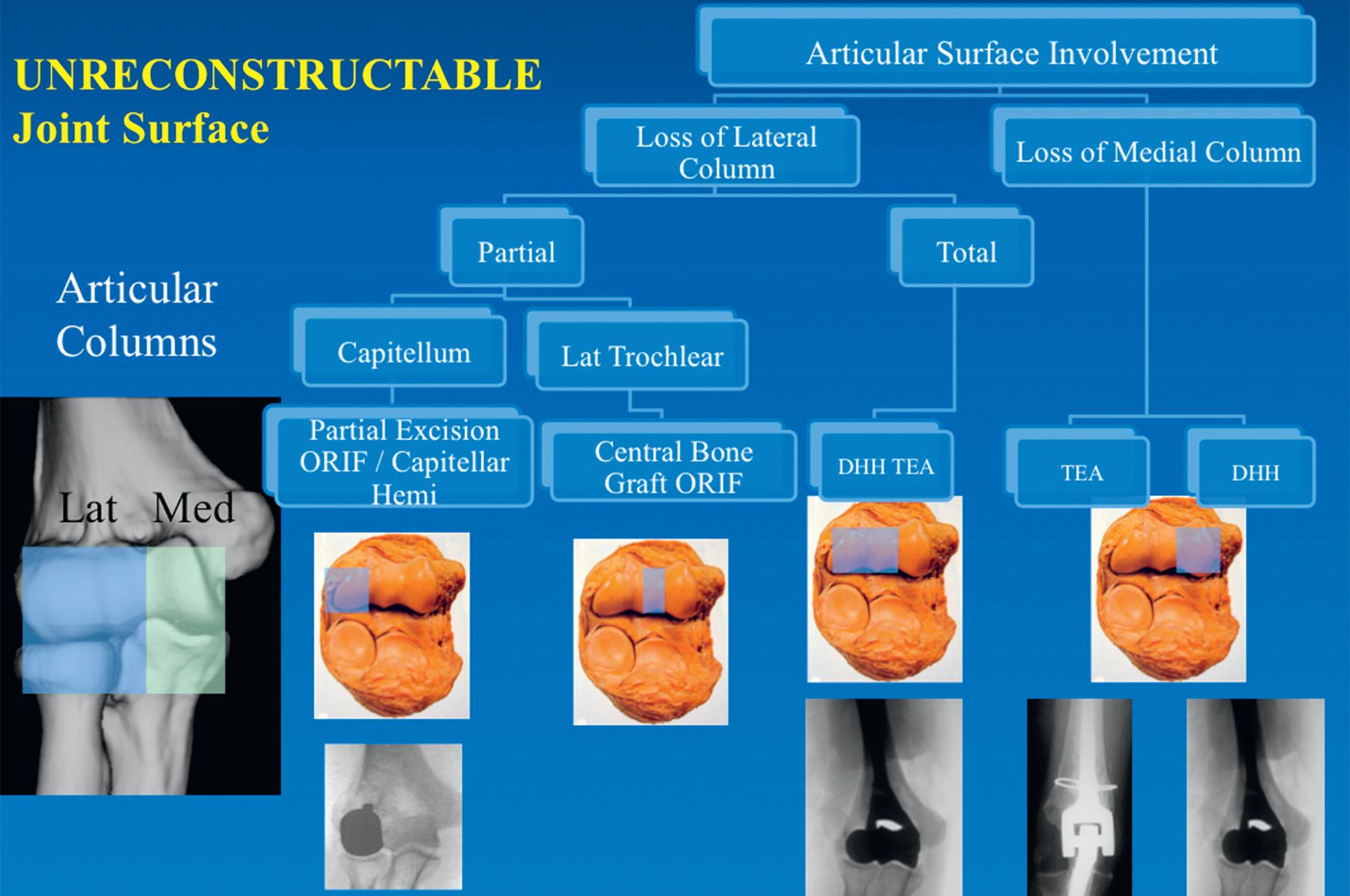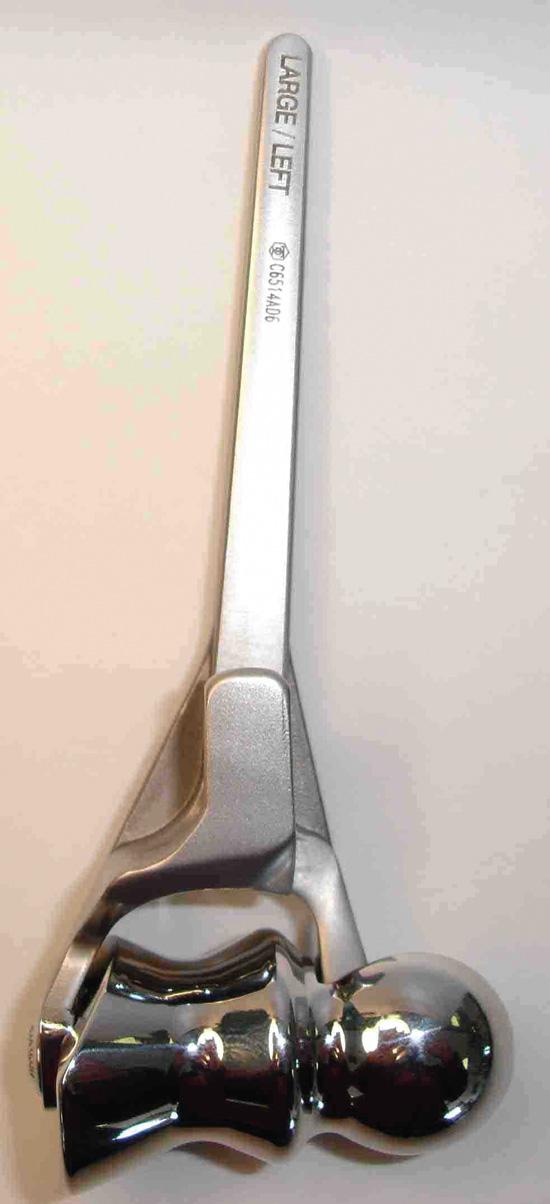Physical Address
304 North Cardinal St.
Dorchester Center, MA 02124
Distal humeral hemiarthroplasty (DHH), although first described in 1947, has attracted increasing interest over the last few years as a surgical option for a number of distal humeral disorders. As a result of the improved understanding of the anatomy and biomechanics of the elbow and the availability of anatomical prostheses, it has been recognized that DHH may provide advantages over current treatments for complex fractures of the distal humerus or pathology that destroys large segments of the distal humeral articular joint surface.
Early series reported the use of a small number of implants a
a References .
in a variety of pathologies, including trauma, inflammatory arthritis, and tumor management. Prostheses were either custom made, nonanatomic (capitellocondylar, Kudo) or had anatomic components (Street). All of these arthroplasties provided options, other than interposition arthroplasty, total elbow arthroplasty (TEA), or open reduction and internal fixation (ORIF) for the treatment of complex elbow pathology.
The choice to perform DHH is based on the general advantages of the procedure over ORIF and TEA, as well as patient-specific lifestyle factors and functional status. DHH eliminates the risk of nonunion, malunion, loss of fixation, and stiffness associated with ORIF, as well as the polyethylene wear associated with TEA. In addition, DHH is not subject to the lifetime 3- to 5-kg weight-bearing restriction and has a lower incidence of component loosening compared to TEA, making it a more suitable choice in younger, higher demand patients.
The indications for DHH are currently evolving according to what is appropriate and achievable and will continue to evolve as longitudinal studies provide more clinical data. Trauma and its sequelae, often in a middle-aged or elderly female, are the most common causes of an unreconstructable distal humeral articular surface. Occasionally a young patient may sustain this type of injury from high-energy trauma. In addition, DHH is an alternative treatment after distal humeral fracture in those elderly patients with demands deemed excessive for traditional elbow replacement.
The interaction of these variables, in the selection process for the appropriate treatment, are summarized in the treatment algorithm ( Fig. 88.1 ).

Current indications for DHH include:
Acute trauma
Comminuted intraarticular fractures in which ORIF will not result in sufficient stability to allow early range of motion
Unreconstructable combined capitellar and lateral trochlear fractures with or without medial trochlear involvement
Coronal shear fractures of the capitellum and lateral trochlea combined with low transverse bicondylar extension
Salvage of failed internal fixation
Chronic malunion or nonunion
Avascular necrosis of the trochlea with collapse of the subchondral bone
Tumors of the trochlea when resection allows preservation of the epicondyles and collateral ligaments
In the early series of DHHs, patients with rheumatoid arthritis reported stiff painful joints. This, however, may not be typical of all cases, and the technique may be of value in the younger patient with “burned-out” disease or the low-demand patient on disease-modifying agents who has an eburnated but congruent joint. In our experience, the use of DHH for primary osteoarthritis is unpredictable with regard to pain relief and motion.
Absolute contraindications include overt local or distant foci of infection, inadequate neurovascular status, insufficient bony support, poor soft tissue coverage, and unstable fracture of the radial head and/or coronoid. Additionally, a nonanatomic sigmoid fossa due to developmental humeral insufficiency (e.g., fishtail deformity) results in poor congruency with a DHH, and TEA may be a more suitable procedure. Relative contraindications include articular cartilage damage of the radial head and sigmoid fossa due to chronic fracture arthrofibrosis or inflammatory arthropathy.
Advances in the understanding of elbow anatomy and biomechanics have helped determine the correct shape and sizing of joint surfaces, as well as the appropriate landmarks for implantation to ensure good stability and function. Street and Stevens designed a near-anatomical DHH spool in 1974. Experience with TEA and the mechanism of humeral component loosening dictates that DHH implants should be stemmed and preferably have an anterior flange to resist joint reactive forces. Currently there is only one TEA system available that allows DHH (Latitude elbow system [Tornier, Stafford, TX]; Fig. 88.2 ). However, it must be noted that the use of the Latitude is not FDA approved in the United States. The Latitude system has three stem sizes (with an anterior flange) and six modular anatomical spools. Although reconstruction of the epicondyles is the preferred option, a central axis hole allows suture fixation of collateral ligament repair, if required. This system theoretically allows conversion to a semiconstrained TEA, but the practicality of this is yet to be demonstrated. In our series, the only loose stems have been in the nonflanged alternative (Sorbie).

Chondral wear is a characteristic of all joint hemiarthroplasties. Biomechanical studies of the Tornier DHH and their contact stresses provides insights into the mode of wear identified in clinical studies and how the current prostheses should be implanted and potentially modified in the future.
Nonsurgical treatment (cast immobilization or “bag of bones”) of displaced intraarticular distal humeral fractures may be considered for low-demand patients with significant medical comorbidities; however, this approach often yields limited function and variable pain relief. This approach has no place in young, healthy patients.
The goals of surgical reconstruction include rigid anatomical restoration of the joint surface that will allow early range of motion. ORIF remains the gold standard of treatment. Series reporting ORIF of comminuted intraarticular fractures indicate a substantial rate of unsatisfactory outcomes and a high complication rate, indicative of the difficulty of achieving these goals in complex cases.
TEA has gained acceptance as a primary treatment for comminuted intraarticular distal humerus fractures in low-demand elderly patients with osteoporotic bone. Its application to young active patients or high-demand older patients is associated with the risk of early prosthesis failure.
The longest follow-up of a custom hemiarthroplasty is 20 years, with good pain relief and functional movement. The literature is limited and is summarized in Table 88.1 . Street and Stevens reported their experience of 10 distal humeral anatomical spools without stems. Of these, five patients had inflammatory arthritis and reported poor movement and implant instability. Five of the patients were posttraumatic, and four of these were pain-free and had good functional movement. Swoboda and Scott implanted the capitocondylar humeral component (nonanatomical) in patients with rheumatoid arthritis and noted variable results. Parsons et al. using the Sorbie-Questor prosthesis (Wright Medical Technology, TN), reported their initial experience of DHH in trauma (four acute and four chronic). The average range of movement was 22 to 126 degrees, with pain improved in all cases. They observed, as have we, that outcomes were better in patients treated acutely compared to chronic fractures. Loss of articular cartilage in the sigmoid fossa and over the radial head may lead to incomplete pain relief, reduced function, and uncertain longevity.
| Author | Year | Number | Prosthesis | F/U (Months) | Mean Age | Mayo | DASH | QuickDASH | Extension | Flexion | Comments |
|---|---|---|---|---|---|---|---|---|---|---|---|
| Mellen and Phalen | 1947 | 4 | Acrylic custom | N/A | N/A | Good pain relief | |||||
| Street and Stevens | 1974 | 10 | Anatomical metal spool | 12–84 | 4 of 5 trauma patients pain free, inflammatory, poor movement | ||||||
| Shifrin and Johnson | 1990 | 1 | Custom prosthesis | 240 | 19 | Good pain relief and ROM | |||||
| Swoboda and Scott | 1999 | 7 | Capitocondylar prosthesis | 25–109 | 20–50 | ||||||
| Parsons and Hughes | 2005 | 8 | Sorbie | 24 | 22 | 126 | Acute did better than chronic | ||||
| Adolfsson and Hammer | 2006 | 4 | Kudo | 10 | 80 | 20 | 126 | ||||
| Adolfsson et al. | 2012 | 8 | Kudo | 53 | 79 | 89 | 31 | 126 | |||
| Argintar et al. | 2012 | 10 | Latitude | 12 | 73 | 77 | 35 | 22 | 121 | ||
| Burkhart et al. | 2011 | 10 | Latitude | 12 | 75 | 91 | 18 | 125 | |||
| Hohman et al. | 2014 | 8 | Latitude | 36 | 64 | 80 | 31 | 19 | 120 | ||
| Smith and Hughes | 2013 | 17 | Sorbie, Latitude | 80 | 60 | 90 | 19 | 17 | 133 | Chondral erosion associated with time since DHH |
Smith and Hughes reported on the medium- and long-term follow-up of 26 patients (mean age, 62; range, 29–92 months) treated with DHH for trauma. Four patients had been revised to TEA: two for periprosthetic fractures and two for primary component loosening (all in prostheses without an anterior flange). Of the six other complications found: four were ulnar neuritis, one was stiffness, and one was wound necrosis. Seventeen patients underwent assessment at a mean of 80 months after surgery. The mean values of the ASES elbow score (pain, 9.93; function, 25; satisfaction, 9.06), MEPS (90), QuickDASH (19), and EuroQol EQ5D (index, 0.84; VAS, 80) outcome measures demonstrate good function and satisfaction with little pain. The mean flexion arc was 17 to 133 degrees. There was no evidence of instability. Radiological evidence of ulnar wear was seen in 13 patients and correlated to increased ASES pain scores, quality of life, and patient satisfaction. The amount of wear correlates with length of time after surgery but not age at the time of surgery. A systematic review of outcomes for 116 patients reported good or excellent results in 67% of postfracture and 58% in nonfracture patients. There was a 27% incidence of complications in fracture and 32% in nonfracture operations.
Become a Clinical Tree membership for Full access and enjoy Unlimited articles
If you are a member. Log in here